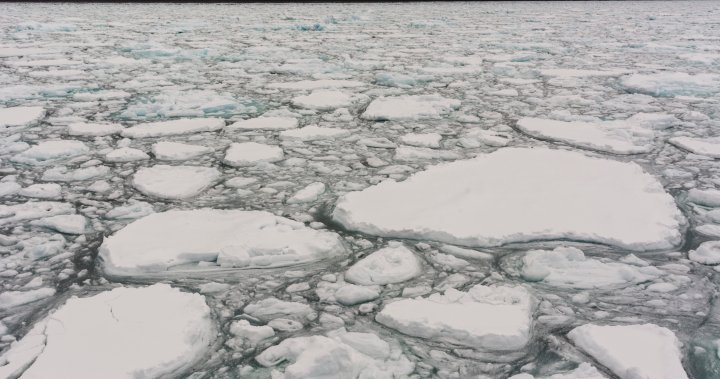Ever wished you could get a second of your life back? Well, that could one day be a reality. And no — we’re not talking about time travel.
A study published Wednesday in the journal Nature investigated how the changing rotation of the Earth — which is not as consistent as you might think — will have huge implications for how we measure time, since we base our calendars and clocks on how long it takes for the Earth to fully rotate.
What the paper found is that melting polar ice caps are redistributing a massive amount of water from the North and South poles across the world’s oceans. This is causing the Earth’s rotation to significantly slow.
You can see this phenomenon play out when a figure skater raises her arms over her head to rapidly spin. When she brings her arms back down, her spin slows. So as more and more water weight is diverted from the poles and distributed around Earth’s bulging centre, so too does the planet’s spin slow.
“Global warming has proceeded to the point that its effects are showing up in how fast the whole Earth rotates,” the study’s lead author, geophysicist Duncan Carr Agnew, wrote in a statement to Global News. “This change in rotation has never been seen before, and this re-emphasizes that we are living in a time when unprecedented changes are happening.”
At the same time however, an opposite force has been making the Earth speed up. For about 50 years, trends in the planet’s core have been causing the Earth to accelerate.
After modelling the implications of these two conflicting forces Agnew calculated that we will need a “negative leap second” event by 2029, in which the world’s clocks go back one second for the first time in history.
“This has never happened before, and poses a major challenge to making sure that all parts of the global timing infrastructure show the same time,” Agnew said.
Earth has been barrelling towards the need for a negative leap second for decades. But Agnew found that the slowing effect of ice melting at Earth’s poles have counteracted this burst of speed and likely delayed this global second of reckoning by about three years, he calculated.
While global warming has apparently postponed this timekeeping problem, Agnew says his study should not been seen as a positive side effect of climate change.
“I think viewing global warming as positive because of its effect on timekeeping is like looking at a polluted lake and viewing it as positive because of the interesting colors,” he wrote.
Tricks of the timekeeping trade
To understand why a negative leap second might be necessary, we first need to understand how the world tells time.
The email you need for the day’s
top news stories from Canada and around the world.
Before the invention of atomic clocks, the second was defined as being 1/86400 of a day, with a day being defined as one full rotation of the Earth. The only problem is that Earth’s rotation can speed up or slow down, meaning the length of a second could be different on any given day.
In 1967, timekeepers introduced the atomic clock as a means to accurately define the second, based on the oscillations of caesium particles as they emit radiation. As one can imagine, this quantum process is a lot more consistent than the movements of a five-septillion-kilogram ball barrelling through space.
First caesium atomic clock, built by the National Physical Laboratory in Middlesex, U.K., pictured in 1955.
Science & Society Picture Library/SSPL/Getty Images
But for a variety of reasons, timekeepers still wanted clocks to keep pace with the rotation of the Earth, so a system of coordinated universal time (UTC), based on atomic clocks, and universal time (UT1), based on the rotation of Earth, was devised.
Since 1972, the world has experienced 27 leap seconds — one extra second added to clocks — in order to keep both UTC and UT1 in time with each other.
This is because UT1, or astronomical time, typically runs a tad slower — mere milliseconds — than UTC, or atomic time. Those daily fractions of seconds added up to whole seconds every few years, so occasionally, a leap second is added. Instead of 11:59 and 59 seconds turning to midnight, there would be another second at 11:59 and 60 seconds.

This leap second system seemed to suppose that astronomical time would always be slower than atomic time. But recently, trends in the Earth’s core have caused the planet to speed up.
You spin me right round
For thousands of years, the Earth has been generally slowing down. But in the mid-2010s, scientists observed that the slowdown rate was decreasing and the Earth was actually starting to speed up.
This is happening because the Earth’s core is molten liquid and has currents that cause it to rotate. Agnew states that, since the 1970s, the rotation of the core has been steadily slowing down, which causes the solid Earth around it to speed up.
This may seem counterintuitive but when one spinning mass slows, it transfers it angular momentum to any mass it’s connected to that can also spin. So a slowing core means the rest of Earth speeds up.
Agnew shared a video to help demonstrate this phenomenon. A man sits on a stool that can spin and holds a bicycle wheel. When he spins the bicycle wheel and it gains momentum, the stool remains at rest and doesn’t spin. But when the man slows down the spinning bike wheel, his stool starts to turn. When he completely stops the spinning of the wheel, the stool turns even faster.
The core has been ramping up towards acceleration for about 50 years, since 1972, Agnew said. But the rapid melting of ice at the poles since 1990 has masked that effect.
Without the effect of melting ice, Earth would need that negative leap second in 2026 instead of 2029.
As for the underlying reason why the Earth’s core is slowing, “We don’t know,” Agnew said.
The limits of the leap second
For decades, astronomers had been keeping universal and astronomical time together with those handy little leap seconds. But computer system operators said those additions aren’t easy for all the precise technology the world now relies on. In 2012, some computer systems mishandled the leap second, causing problems for Reddit, Linux, Qantas Airlines and others, experts said.
In 2022, the world’s timekeepers decided that starting in the 2030s they’d change the standards for inserting or deleting a leap second, making it much less likely.
Tech companies such as Google and Amazon unilaterally instituted their own solutions to the leap second issue by gradually adding fractions of a second over a full day.
But subtracting a leap second instead of adding one creates a whole new host of problems. It might be harder for computer programs to skip a second because they’re designed to add time, not subtract it.
“Many computer programs for leap seconds assume they are all positive, so these would have to be rewritten, something even less likely to be done correctly for all computers,” Agnew said.
Why go through all this trouble to be accurate to the second, though?
“A second doesn’t sound like much, but (for example) the EU standard for timing stock-market trading is that
the time of all trades has to be accurate to 0.001 seconds,” he explained, adding that lots of systems, including electric power grids, depend on accurate time.
Agnew hopes that his paper will encourage the timekeeping community to drop the leap second altogether.
“All this means is loosening the requirement that UTC and UT1 never be more than a second apart. If these timescales could differ by up to a minute, a negative step would be extremely unlikely, and positive steps could be scheduled decades in advance.”
— with files from the Associated Press







